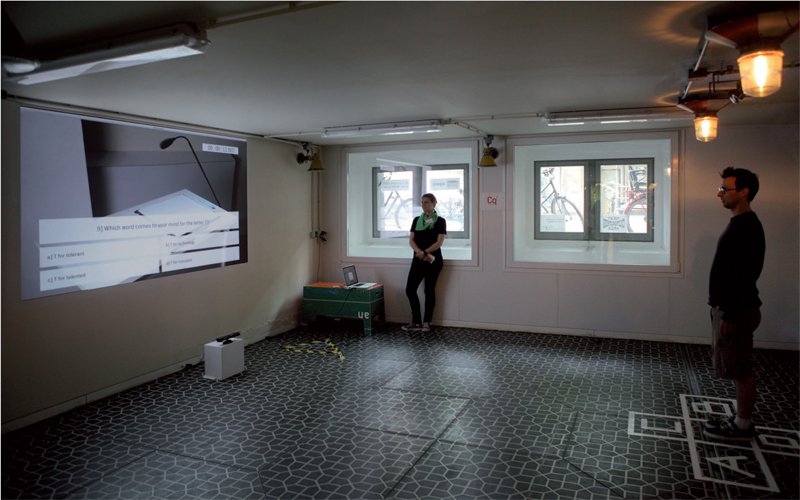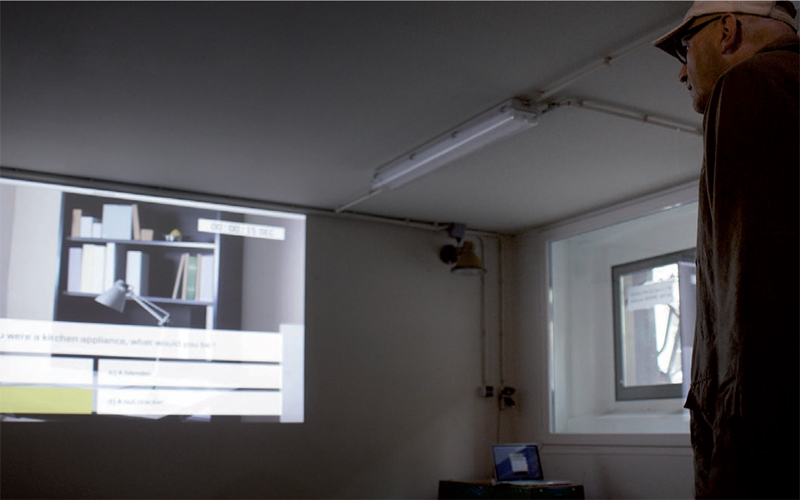User:Michaela /trimester 3: Difference between revisions
No edit summary |
No edit summary |
||
| (One intermediate revision by the same user not shown) | |||
| Line 5: | Line 5: | ||
<h2>Artist statement:</h2><br> | <h2>Artist statement:</h2><br> | ||
In the field of entertainment the production is often outsourced to cheap labour, whereas the creative | In the field of entertainment the production is often outsourced to cheap labour, whereas the creative | ||
part of the designer is | part of the designer is honoured. While reflecting on mechanism of the creative industry, two sides emerged | ||
with a strong ambiguity. This is why we want to question the definition of the creative part on the one | with a strong ambiguity. This is why we want to question the definition of the creative part on the one | ||
hand and the role of the worker on the other hand. | hand and the role of the worker on the other hand. | ||
| Line 20: | Line 20: | ||
Some of the questions refer to Richard Florida text “ The Rise of the Creative Class” where the creativity is an important social status. The multiple answers were collected from various sources - a carrier positions requirements of the top and most wanted creative corporations such as Google, Apple, Facebook etc. | Some of the questions refer to Richard Florida text “ The Rise of the Creative Class” where the creativity is an important social status. The multiple answers were collected from various sources - a carrier positions requirements of the top and most wanted creative corporations such as Google, Apple, Facebook etc. | ||
The form of the CQ 7 test allowed us to create a notion of predominant examination. The visitor has been assessed, scored and evaluated as being creative or not. The hierarchy of the superstructure or the superiority of certain people as being more creative than others arise. The base is where the less creative people are constantly examined and colored as such. For example google ranking system represented in different color badge which indicates certain status in the system. The green refers to intern or the lowest rank, the red | The form of the CQ 7 test allowed us to create a notion of predominant examination. The visitor has been assessed, scored and evaluated as being creative or not. The hierarchy of the superstructure or the superiority of certain people as being more creative than others arise. The base is where the less creative people are constantly examined and colored as such. For example google ranking system represented in different color badge which indicates certain status in the system. The green refers to intern or the lowest rank, the red coloured represents the contractors and the white is honoured to full- time employees. | ||
The result in CQ 7 is completely random. There are four percentage ranges estimating the level of the creativity of the participant which refer to different color code ( from 0 to 28 grey color – low; 24 – 49 green color -moderate; from 50 to 74– blue color - fair; and 74 to 99 red color – high). | The result in CQ 7 is completely random. There are four percentage ranges estimating the level of the creativity of the participant which refer to different color code ( from 0 to 28 grey color – low; 24 – 49 green color -moderate; from 50 to 74– blue color - fair; and 74 to 99 red color – high). | ||
| Line 53: | Line 53: | ||
== Media == | == Media == | ||
>>> [[Media: CQ7AbilityTest.pdf|<font color=" | >>> [[Media: CQ7AbilityTest.pdf|<font color="66CCFF">CQ7 Ability Test</font>]]<br> | ||
The visuals consist of thirteen staged scenes of working environments. | The visuals consist of thirteen staged scenes of working environments. | ||
They illustrate and visualize the empty almost polish and sterile office spaces. | They illustrate and visualize the empty almost polish and sterile office spaces. | ||
Latest revision as of 10:40, 26 November 2013
Michaela Lakova, Trimester 3, 2013
Thematic Project & Self-Directed Project - Creative Industries
CQ7 Creative Ability Test (Michaela Lakova & Nicole Hametner)
Artist statement:
In the field of entertainment the production is often outsourced to cheap labour, whereas the creative part of the designer is honoured. While reflecting on mechanism of the creative industry, two sides emerged with a strong ambiguity. This is why we want to question the definition of the creative part on the one hand and the role of the worker on the other hand. An interactive video installation provides a survey where the spectator can run through 13 questions with 4 proposed answers. As foundation serve different examples of job interviews for companies in the creative industry. The result expresses in percentage to what extend the respondent fits into the profile of either the creative or the worker. He then receives his test result as a badge to present afterwards in the exhibition space, with the aim to initiate a discussion about his achieved level and to reflect about the meaning of the two categories, where they distinguish from each other and where they might at the end not differ at all.
Questions & Answers
The content of the questions evolve from most common job interview questions to more discomfort concern supervision, data protection, deadlines and pressure, work - life balance and public-private. Some of the questions refer to Richard Florida text “ The Rise of the Creative Class” where the creativity is an important social status. The multiple answers were collected from various sources - a carrier positions requirements of the top and most wanted creative corporations such as Google, Apple, Facebook etc.
The form of the CQ 7 test allowed us to create a notion of predominant examination. The visitor has been assessed, scored and evaluated as being creative or not. The hierarchy of the superstructure or the superiority of certain people as being more creative than others arise. The base is where the less creative people are constantly examined and colored as such. For example google ranking system represented in different color badge which indicates certain status in the system. The green refers to intern or the lowest rank, the red coloured represents the contractors and the white is honoured to full- time employees. The result in CQ 7 is completely random. There are four percentage ranges estimating the level of the creativity of the participant which refer to different color code ( from 0 to 28 grey color – low; 24 – 49 green color -moderate; from 50 to 74– blue color - fair; and 74 to 99 red color – high).
This work was made in the context of the thematic project Creative Industries.
For the connecting link between the individual works in the final collective show, the group decided to
create a start up event, where each of the participants presents its project as a start up business.
For this reason we had to adapt our initial artist statement into a creative business idea and transformed it
into a new company statement:
Discover your potential and be part of the creative workforce of tomorrow!
CQ7 Creative Ability Test allows job hunters to check their potential to work in the creative industry.
We use big data and predictive analytics to improve workforce quality, productivity and profitability, by
connecting qualified employees with employers.
We are an independent research group of data analysts using profiling technology. With the CQ7
Creative Ability Test we offer a survey that allows individual job hunters to check their potential to work in
the creative industry. The respondent cannot fail or pass the test, the result rather represents his potential
expressed in a numerical form of his achieved level. It is then the company that decides to what degree
creativity is demanded for their working procedures. In addition to this individual outcome, the collected
data are used for statistic evaluation, which serves as guideline for companies working in the field.
We use big data and predictive analytics to improve workforce quality, productivity and profitability, by
connecting qualified employees with employers.
During the event we offer a free trial version in form of an interactive installation to allow the audience
to be part of the procedure. The respondent receives his test result as a badge to present afterwards in
the exhibition space, with the aim to initiate a discussion about his achieved level. Our staff members are
present during the day and provide assistance for the participants as well as for any further questions
from the public.
The creative business ideas were introduced the evening before the start up camp during a Pecha Kucha
event. The format of this presentation was simple: the participants had two and a half minutes with 10 slides 15 seconds each to present their product. www.startupcampl.nl
>>>Presentation Slides CQ7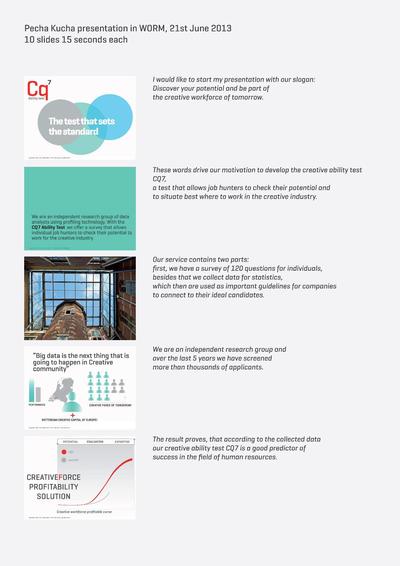
Media
>>> CQ7 Ability Test
The visuals consist of thirteen staged scenes of working environments.
They illustrate and visualize the empty almost polish and sterile office spaces.
The absence of people and the idea of just left trace of presence creates the ambiguity of real vice verse fictional working atmospheres and situations contextualized in the questions.
As a visual references and influence served the photographs of Thomas Demand.
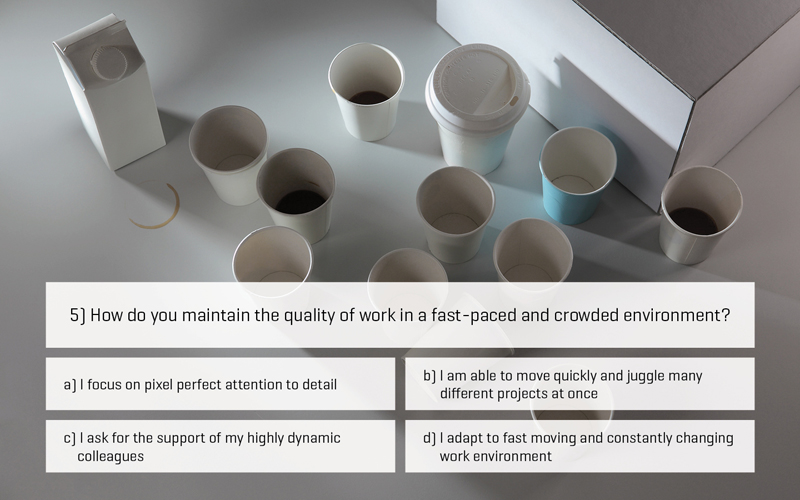
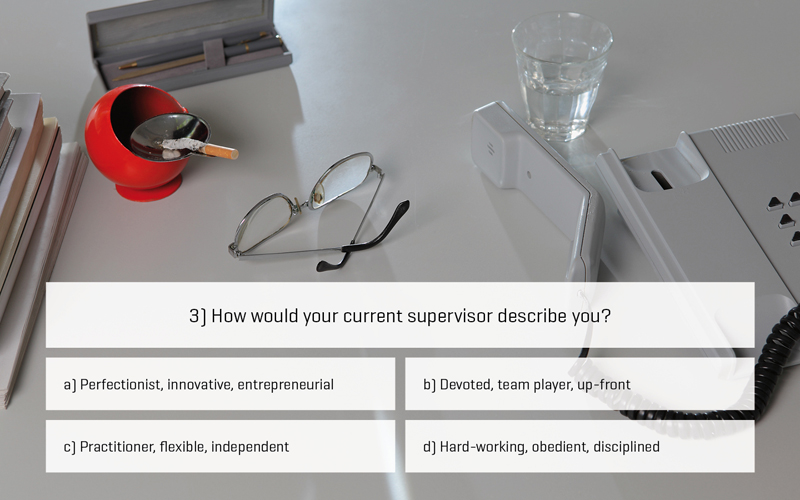

Worm Event
References:
The rise of the creative class Richard Florida
Facebook careers
Google Job Interview
Jung Typology Test
Evolv Test Survive
Bladerunner VK Test
The machine readable workforce

